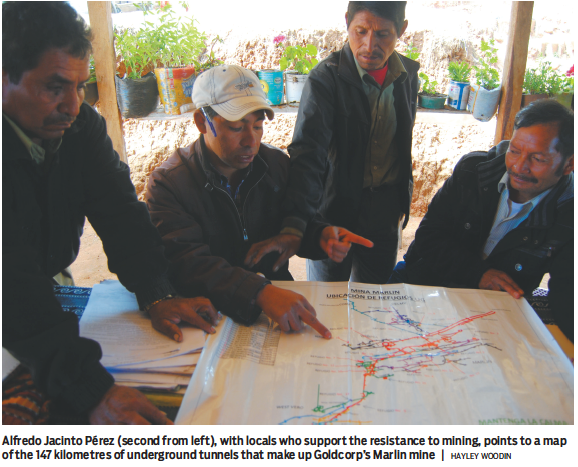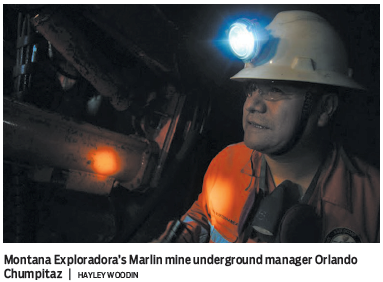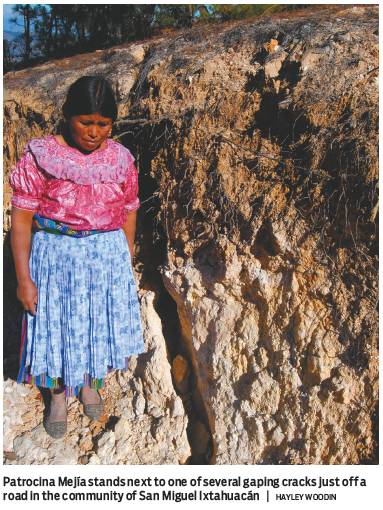By Hayley Woodin
(Image: Diadora Hernández, who owns three hectares of land in San Miguel Ixtahuacán, says she has experienced violence over her refusal to sell it to Montana Exploradora | Photo: Hayley Woodin)
It's a warm, late-January day in the northwestern highlands of Guatemala. A dozen cattle range lazily on the sloped terrain; hundreds of corncobs lie drying under tarps in the hot afternoon sun.
Chickens and turkeys peck their way around Diadora Hernández’s heritage: the two hectares of land she inherited from her father. She has managed to expand the operation to three through years of hard work.
For many Guatemalans living in rural regions, land equals life, survival. It’s also a significant part of indigenous culture and tradition, and the Guatemalan highlands are dominated by the Mam, Maya and Sipakapense peoples.
Holding on to what’s hers, however, has come at an incredible cost for Hernández.
In 2010, she says, two men came onto her property in the municipality of San Miguel Ixtahuacán and shot Hernández in the head at point-blank range. She survived but lost her right eye, the hearing in her right ear and the feeling in half her face.
She claims the men attacked her because she had refused to sell her land to Montana Exploradora, which has been operating one of the world’s biggest gold mines in northwestern Guatemala for close to a decade. To date, no one has been held accountable for the crime.
Hernández still suffers physical pain, but it’s the emotional pain that hurts most. She says the mining project has uprooted her community and turned her neighbours into enemies.
There are many stories like hers, though most are not as extreme. There are just as many stories that contradict them or highlight the good Canadian mining companies do for the communities in which they operate.
Despite the widely opposing views, confusion and disagreement, one thing is certain: mining in Guatemala has divided communities along hard lines, with both sides unable to see eye to eye.
Marlin mine
Since 2005, Montana has operated Marlin – an open-pit and underground mine site in the Guatemalan department of San Marcos. It spans the municipalities of San Miguel Ixtahuacán and Sipacapa, which are divided into dozens of communities made up of hundreds of villages sprinkled across mountains and valleys.
The villages are small and quiet, with the majority of the population made up of farmers who survive on subsistence farming. The slightly more “urban” towns have small shops, carts carrying trinkets and restaurants that are sometimes no more than just the back rooms of humble homes.
When the Marlin mine began operations, Montana – incorporated as a Guatemalan company – was a wholly owned subsidiary of Glamis Gold. The project was inherited by Vancouver-based gold giant Goldcorp Inc. (TSX:G) when the company merged with Glamis in 2006.
Today, the project comprises 147 kilometres of underground tunnels. In 2013, it generated $447 million in revenue and produced 202,200 ounces of gold – about 7.6% of the 2.67 million ounces produced overall by Goldcorp in 2013. This year, the company expects Marlin to produce between 160,000 and 175,000 ounces of gold.
Montana is reclaiming its open-pit mine, a $15 million process the company says should be complete by 2017. The Guatemalan government is considering a hike in royalties paid by mining and extractive countries and has placed a countrywide moratorium on issuing exploration or exploitation licences – one reason the Marlin pit is three-fifths of the way closed.
Both Goldcorp and its subsidiary maintain that despite uncertainty at the federal level, the mine’s success has ultimately brought much-needed development to the region of San Marcos, a five-hour drive from the capital, Guatemala City. Montana also maintains that despite the current government’s increasing outward opposition toward mining – it’s an election year in Guatemala – local opinion about the mine is heading in the other direction.
Acknowledging that the project has been controversial, the company claims community fears over water contamination, cracked houses from explosions and illegal land claims have been largely discredited.
“At the outset they were pretty much manipulated into believing that we were to destroy the whole environment and they will suffer a lot of disease and illnesses, and that has not been the case,” said Montana president Mario Marroquín, referring to local opposition to Marlin. “The best proof is that now the communities do not have particular worries about health or environment. Their worries are about income generation and job opportunities.”
While he couldn’t provide an exact number, Marroquín said Montana’s human resources office is packed with job applications and that most of the complaints the company receives through its community dialogue mechanisms are merely queries about work or concerns over job availability.
“It’s like we have gone from being in a rather hostile environment to a situation in which more [or] most of the people would like to work for us somehow or the other.”

This is a starkly different reality from 10 years ago, according to the Mayan Sipakapense Council in Defense of Territory (Sipakapense Council). In 2005, as the mine was preparing to open, residents from the municipality of Sipacapa held a community referendum to determine whether they would support Montana mining in the region.
Only one in five people turned out to vote, but, of those, 98% voted against mining. Guatemalan courts found the public consultations valid but not binding, stating mining ultimately fell under the jurisdiction of the state, and not under the control of the municipality.
ILO 169
Thirteen men from Sipacapa gather around a long table in the courtyard of one of their houses. They are tense and carry reserved distrust on their faces. The mood is broken slightly by children and chickens playing nearby, and a baby crying out from one of the rooms on the lot. There are no doors or window panes to quiet the sound, but it’s January and it’s warm.
Alfredo Jacinto Pérez, a community spokesman and leader of the Sipakapense Council, claims that despite a former promise, Montana resumed exploration work in 2011, which prompted a reinvigorated resistance movement aimed specifically at defending the results of the 2005 public consultations.
“Why do I continue with the struggle? Why do we continue the struggle? Because we love our water. We love our land, we love our natural resources. This is why we’re in the struggle,” he said.
It’s a struggle that’s both incredibly personal and hyper-local. And while it’s narrated by stories of people like Hernández, modern international law and human rights issues underscore nearly every aspect of what Jacinto and his colleagues are fighting to achieve in remote villages with big history.
The struggle in this case is based on ILO 169 – the International Labour Organization’s Indigenous and Tribal Peoples Convention, ratified by Guatemala in 1996.
ILO 169 protects the right of indigenous peoples to prior consultation before the government grants permits to explore or exploit natural resources. Upholding it is the responsibility of the Guatemalan government – a relatively new democracy overseeing a country still healing from three decades of civil war and a history of genocide.
Similar rights are enshrined in the country’s constitution. Part of Guatemala’s Peace Agreements, which ended its bloody civil war, also acknowledges rights to traditional lands, rights to the administration of natural resources on or near their lands and the entitlement to certain compensation and restoration rights.
“We’re very careful about respecting the rule of law,” said Montana’s Marroquín.
But determining and upholding the law in a country known for its corruption is challenging.
An independent human rights impact assessment (HRIA) conducted by external auditors at the request of Goldcorp shareholders in 2010 found that Montana legally obtained its licences to operate in Guatemala, and the company is adamant that it has met and exceeded the legal requirements to mine in the country. But evidence suggested proper consultation did not occur before the company was granted both exploration and exploitation licences, a violation of international law.
But the report’s assessors – Vancouver-based On Common Ground Consultants – also determined that no adequate legal, regulatory or institutional framework existed in Guatemala to uphold ILO 169.
Brent Bergeron, executive vice-president, corporate affairs and sustainability, at Goldcorp, said that 10 years ago there were some “considerations that were not in place” at the start of the mine’s operations.
“When we look at what was originally done with the project and how mining companies operated back then, there’s been some significant changes over a period of 10 years in terms of how companies ensure that they are working in partnership with the communities through their project,” Bergeron said. “Now the way we start projects is quite different.”
Bergeron said Goldcorp has taken the report’s recommendations and has brought them forward to communities and worked on them together. And as a result much has changed for the benefit of all involved.
Environment and IACHR
The Sipakapense Council is also worried about water contamination.
In 2010, the Inter-American Commission on Human Rights (IACHR) asked the state of Guatemala to suspend all activities related to the concessions granted to Goldcorp and Montana, including operations at Marlin, and to “implement effective measures to prevent environmental contamination.”
The precautionary measure was granted on behalf of 18 Maya communities that, in addition to alleging mining at Marlin began without prior consultation of those affected, alleged that several water wells and springs had dried up and that metals were found in the water, harming the health of community members.
The IACHR modified its precautionary measures in 2011, requesting the state of Guatemala adopt necessary measures to ensure the 18 Maya communities have access to potable water. The revision, made “after examining additional information submitted by the state and the petitioners,” according to the IACHR, made no references to Goldcorp or Montana.
The Sipakapense Council, alongside residents in neighbouring San Miguel, have filed legal motions before Guatemalan courts to ensure the government does provide access to clean water in the 18 communities.
According to Jacinto, potable water is desperately needed. And while Montana has offered resources to the municipal mayor’s office for a water project, he worries that accepting it would allow the government to say it has lived up to its commitment to comply with IACHR water measures.
“They’re destroying all the local water systems,” said Gregoria Cruz, an active mine dissident in the community of San Miguel. “No constant supply of water. Sometimes we have water, sometimes we don’t. So we have water projects that have dried up, like water wells that we’ve dug that have dried up. We don’t have a constant, daily supply of water. And it’s contaminated. If there’s no water, we have to drink contaminated water.”
Montana’s Marroquín is well aware of the concerns regarding water, but he said it has nothing to do with the Marlin mine.

“There are certain instances that have been identified as being recurrent in the area, and they have nothing to do with the mining process,” Marroquín said. “They have to do mostly with poverty, living conditions and poor health management within the household. And the conclusion is that water sources and springs may be contaminated mostly by bacterial cultures – it’s because of the way people handle their own health hygiene.”
“They live with the cattle and animals in the same areas where they have the water sources,” said Filogonio Gómez, who works in Montana’s communications department. “And the water supplies don’t have the same filtration systems such as chlorine. That’s the main reason for that contamination in the water.”
One of the problems may be a lack of data.
Both a 2010 evaluation by E-Tech International, which looked at the environmental and social impact asessment prepared by Glamis Gold to procure its mining licence, and Goldcorp’s HRIA talked of a lack of baseline information for comparison purposes. The E-Tech report also concluded that “claims that springs in the area have been affected by the mine cannot be fully addressed without a more complete hydro-census and groundwater monitoring program.”
Goldcorp has now created a group that works closely with communities to monitor and test water quality regularly, with the goal of both addressing community concerns around water contamination and encouraging communities to undertake their own monitoring projects.
A Tufts University report, Economic Benefits and Environmental Risks of the Marlin Mine, acknowledged that governmental oversight has improved since the mine was first approved, though enforcement is still lagging and water quality monitoring is irregular. Montana carries out its own annual monitoring reports and maintains it hasn’t affected the environment, although without baseline data it’s difficult for anyone to conclude whether any changes have occurred, for better or for worse.
“There’s no contamination whatsoever of heavy metals at all,” said Marroquín. “But it’s how these organizations frame it. They discover that there’s something in the water –yes there is, but it’s throughout the country.”
“A lot of non-government organizations [NGOs] have a no-mining policy in Guatemala,” said José Carlos Quezada, the head of Montana’s environmental department.
Rights Action is one such NGO, along with groups MiningWatch Canada and Development and Peace, that has been denouncing mining and megaprojects in Central America since 2004.

“You cannot operate a large-scale mining operation in Guatemala and not violate human rights of the local populations. You cannot operate a mine there and not harm the environment. That’s just how the country operates,” said Grahame Russell of Rights Action, which has been supporting the communities around Marlin with financial aid and advocacy.
“When they say they’re abiding by the rule of law in Guatemala, and they’re doing business with the democratically elected government of Guatemala, I think they are knowingly misleading the public, and knowingly misleading investors and shareholders,” Russell said. “Anyone who pays the remotest amount of attention to issues of democracy and the rule of law in Guatemala knows that it’s a profoundly undemocratic country, and the rule of law is deeply corrupted and dysfunctional.”
Goldcorp understands there will always be opposition.
“In all projects, in all that we do, I think it’s quite impossible to think that we are able to convince 100% of the population in terms of having complete acceptability of the project,” Bergeron said. “Now we know in San Miguel and Sipacapa that there are still people who oppose mining as a general theme and are not in agreement with the way that we are working with the communities.”
“I understand that there are some people who don’t feel that mining is an activity that they want to see in their area,” he added.
“We try to be respectful of their opinion, but we also work with the people who are the elected officials in those areas to try to make sure that the information that we provide to them is provided to everybody in the community.” •




